Containerization technology has transformed software development and deployment, allowing teams to push apps to production minutes after development.
The container management market size reached 944 million USD in 2024. This has drastically reduced release cycles and boosted operational efficiency.
While Docker was once the industry standard, it now faces strong competition and businesses are turning to Docker alternatives.
In this article, we explore the 7 best docker alternatives for 2025, providing you with the insights needed to choose the best containerization tools for your needs.
However, let’s begin by understanding Docker.
What is Docker?
Docker is a platform designed for developing, shipping, and running applications. By using Docker for tasks like shipping, testing, and deploying apps, you can significantly reduce the time between writing code and running it in production.
Docker enables you to package and run applications within loosely isolated environments called containers.
This isolation allows you to run multiple containers on a single host, and the containers themselves are lightweight, containing everything required to run the application. As a result, you don’t need to install dependencies each time you deploy on a new machine.
Table of Contents
Understanding what Docker is lays the foundation for exploring Docker alternatives for developers, as it helps highlight why businesses are now considering other container solutions to meet their evolving needs.
Docker Alternatives: Why You Should Consider Them for 2025?
Docker alternatives are the best container tools that provide similar features and capabilities but address specific challenges Docker faces, such as licensing changes, resource usage concerns, and security issues.
They offer several viable options, many of which comply with the Open Container Initiative (OCI) standards, ensuring flexibility and compatibility across tools.
Understanding these OCI standards enables seamless transitions between containerization tools without overhauling your entire infrastructure. With these alternatives, you can overcome Docker’s limitations and possibly discover solutions better suited to your needs.
Get expert assistance to streamline your workflow. Book a call now , and let us guide you to strategize your operations!
7 Best Docker Alternatives to Power Your 2025 Containerization Strategy
1. Podman
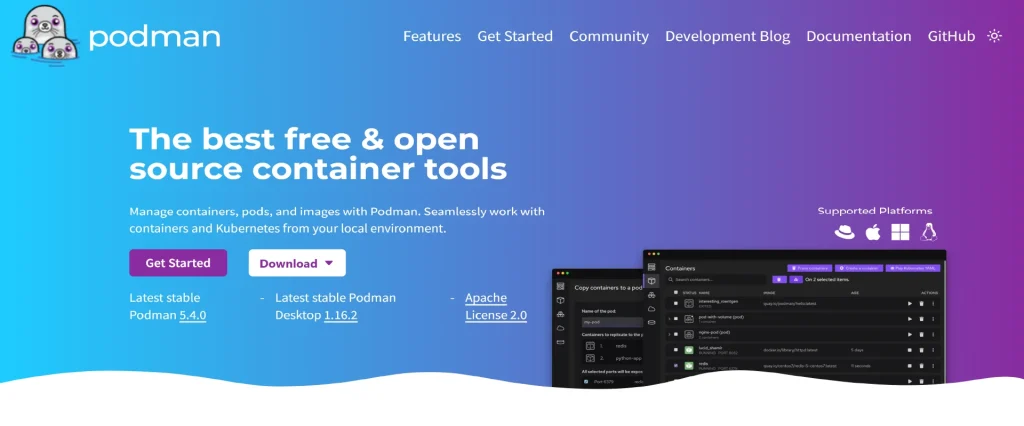
Podman distinguishes itself from Docker with its daemonless architecture, which means it doesn’t require root privileges to run containers. In contrast, Docker demands root access for tasks such as managing the network stack, controlling the file system, and handling group management.
The key advantage of Podman’s daemonless architecture is the enhanced security it offers, as it runs containers as child processes of the calling user. This reduces potential attack surfaces compared to Docker’s central daemon process.
Key Features:
- Docker Compatibility: Podman can be used as a direct drop-in replacement for Docker, supporting familiar Docker CLI commands and containers.
- Rootless Container Execution: Podman enhances security by removing the need for root privileges, making it ideal for sensitive environments.
- Integration with Buildah: It allows the efficient creation of OCI-compliant images without requiring a full Docker daemon, providing more flexibility in image creation.
Feature Comparison:
| Feature | Docker | Podman |
|---|---|---|
| Architecture | Relies on a central daemon to manage containers | Daemonless architecture, enabling rootless execution |
| Security | Requires root privileges, increasing security risks | Improved security with rootless and daemonless design |
| Resource Usage | Higher overhead due to the central daemon process | Lower resource consumption and more efficient management |
| Ease of Use | Simple and user-friendly CLI | Docker-compatible commands for an easy transition |
| Use Cases | Suitable for general-purpose containerization | Best for secure environments needing granular container control |
2. LXC (Linux Containers)

LXC (Linux Containers) offers system-level virtualization, enabling multiple isolated Linux systems to run on a single host. Unlike Docker, which focuses on application-level containerization, LXC provides a complete operating system environment for its containers.
Key Features:
- Minimal Overhead: LXC containers have lower resource consumption compared to traditional virtual machines, leading to more efficient use of system resources.
- Flexibility: LXC supports both privileged and unprivileged containers, allowing users to choose between enhanced security or more functionality based on their needs.
- LXD Management: LXC integrates with LXD for advanced container management solutions, offering scalability, automation, and container orchestration tools.
Feature Comparison:
| Feature | Docker | LXC (Linux Containers) |
|---|---|---|
| Architecture | Application-level containerization | System-level virtualization with full Linux OS environments |
| Security | Moderate security with isolation via namespaces | Strong isolation with support for both privileged and unprivileged containers |
| Resource Usage | Less resource-intensive than VMs but more than LXC | Lower overhead, closer to OS-level virtualization with minimal performance impact |
| Ease of Use | User-friendly, with extensive support and community tools | Requires more expertise, offering greater control to advanced users |
| Use Cases | Ideal for application deployment and microservices architecture | Best for scenarios requiring full OS-level virtualization |
3. Buildah
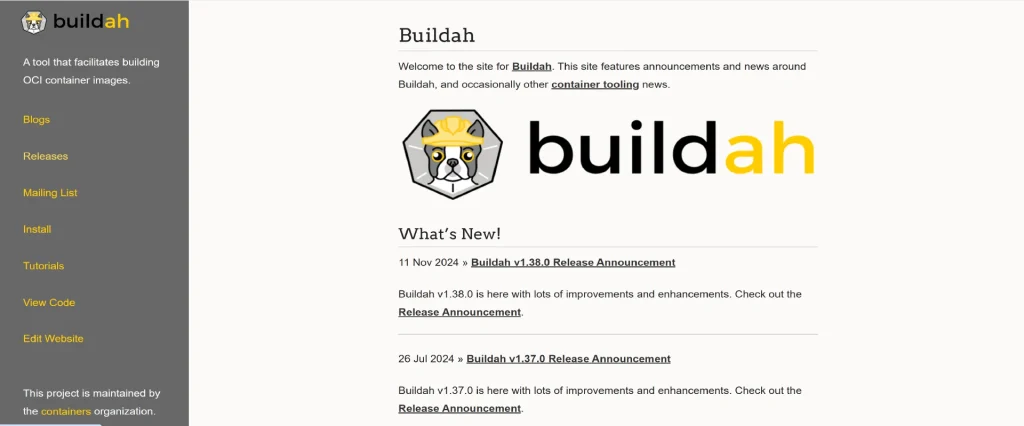
Buildah is a powerful tool designed for creating OCI-compliant container images without relying on a running daemon. It offers a flexible approach to image building, enabling the creation of complex and highly customized container images.
Key Features:
- Daemonless Image Creation: Builds images without the need for a persistent background daemon, enhancing security and reducing resource consumption.
- Fine-Grained Control: Offers detailed control over every stage of the image-building process, making it ideal for advanced and tailored builds.
- Seamless Podman Integration: Works seamlessly with Podman, providing a comprehensive solution for container image creation and management.
Feature Comparison:
| Feature | Docker | Buildah |
|---|---|---|
| Architecture | A comprehensive platform for both image building and container management | Focused solely on building OCI-compliant images |
| Security | Follows standard security practices | Enhanced security with daemonless image building |
| Resource Usage | Moderate resource consumption | Lightweight, optimized for efficient image creation |
| Ease of Use | User-friendly with a broad range of tools | Requires familiarity with image-building processes |
| Use Cases | General-purpose containerization and application deployment | Advanced image customization and complex build workflows |
4. Kubernetes

While primarily known as an orchestration platform, Kubernetes has evolved into a robust alternative to Docker for managing containerized applications. Its ability to support multiple container runtimes makes it a highly flexible solution for diverse needs.
Kubernetes also includes CRI-O, a lightweight and secure container runtime designed specifically for Kubernetes, providing an efficient alternative to Docker for running containers within clusters.
Key Features:
- Runtime Flexibility: Supports various runtimes like Containers and CRI-O, enabling users to tailor their infrastructure to specific requirements.
- Extensive Ecosystem: Offers a rich set of tools, extensions, and plugins that enhance its core functionality, making it a highly adaptable platform.
- Advanced Orchestration: Built-in features such as auto-scaling, rolling updates, and self-healing simplify the management of large-scale, distributed systems.
Feature Comparison:
| Feature | Docker | Rancher Desktop |
|---|---|---|
| Architecture | Container management and orchestration | Advanced orchestration platform with support for multiple runtimes |
| Security | Standard container isolation | Strong security features, integrated with an extensive ecosystem |
| Resource Usage | Moderate, with scaling options | Scalable resource management suitable for complex environments |
| Ease of Use | Simple for single-node deployments | Complex setup, optimized for large-scale, production-grade systems |
| Use Cases | Small to medium-sized deployments | Large-scale, multi-container environments requiring orchestration |
5. Hyper-V Containers (Windows)
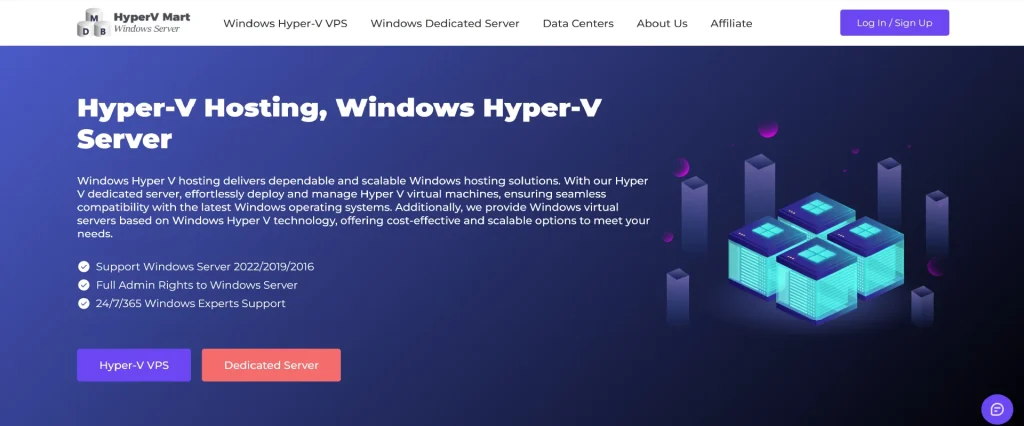
Hyper-V Containers are designed specifically for Windows environments, leveraging hardware-level virtualization to enhance security and performance. By isolating containers at the hardware level, they provide an additional security layer, protecting both the host system and the container runtime from potential threats.
Key Features:
- Hardware Virtualization: Utilizes Hyper-V technology to achieve hardware-level isolation, enhancing security and reducing performance interference.
- Windows Compatibility<: Fully integrated with Windows Server and Windows 11, making it a seamless fit for existing Microsoft-based infrastructures.
- Ecosystem Integration: Operates smoothly within the broader Windows container ecosystem, offering native compatibility with Microsoft tools and services.
Feature Comparison:
| Feature | Docker | Hyper-V Containers (Windows) |
|---|---|---|
| Architecture | Linux-based containerization | Windows-based with hardware-level isolation via Hyper-V |
| Security | Software-level isolation | Improved security through hardware virtualization |
| Compatibility | Primarily for Linux environments | Native support for Windows Server and Windows 11 |
| Performance | Efficient on Linux but higher overhead on Windows | Better performance on Windows with Hyper-V |
| Use Cases | Cross-platform containerization | Windows-specific applications and Microsoft-centric environments |
6. Red Hat OpenShift
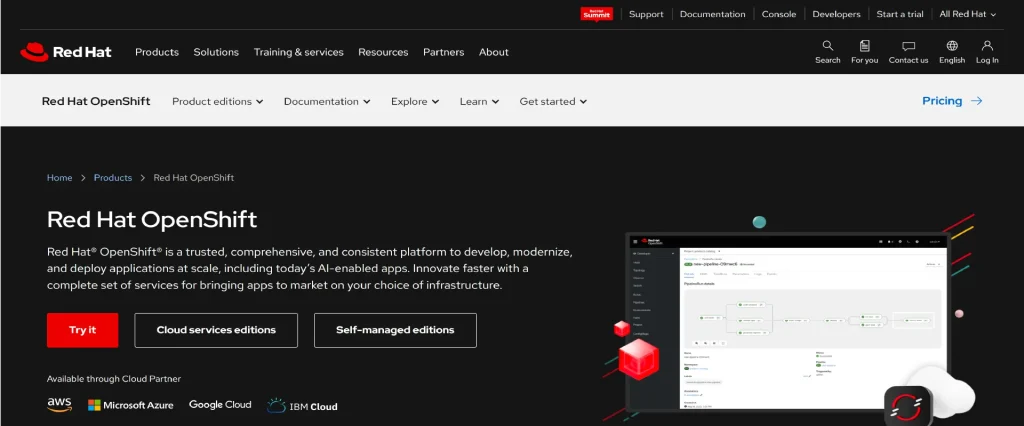
Red Hat OpenShift is an enterprise-grade container platform built on top of Kubernetes. It offers additional tools and features to meet the demands of businesses. It streamlines application deployment, management, and scaling while enhancing security and developer productivity.
Key Features:
- Integrated Processes: Includes built-in CI/CD pipelines, developer workflows, and automation tools to improve team efficiency and collaboration.
- Improved Security: It offers advanced security features, including Role-Based Access Control (RBAC) and network policies. Additionally, it includes compliance tools to meet industry standards,
- Runtime Flexibility: Supports multiple container runtimes like CRI-O, offering deployment flexibility across diverse environments.
Feature Comparison:
| Feature | Docker | Red Hat OpenShift |
|---|---|---|
| Architecture | Container management and orchestration | Advanced orchestration platform built on Kubernetes with multi-runtime support |
| Security | Standard container isolation | Complete security (RBAC, network policies), integrated tools like OpenShift Pipelines, Insights, and Ansible |
| CI/CD Integration | Limited built-in capabilities | Built-in CI/CD pipelines, developer workflows, and automation |
| Support | Community support available | Enterprise-grade support and Red Hat’s ecosystem services |
| Use Cases | Small to medium-sized deployments | Large-scale, production-grade applications in regulated industries |
7. Rancher Desktop
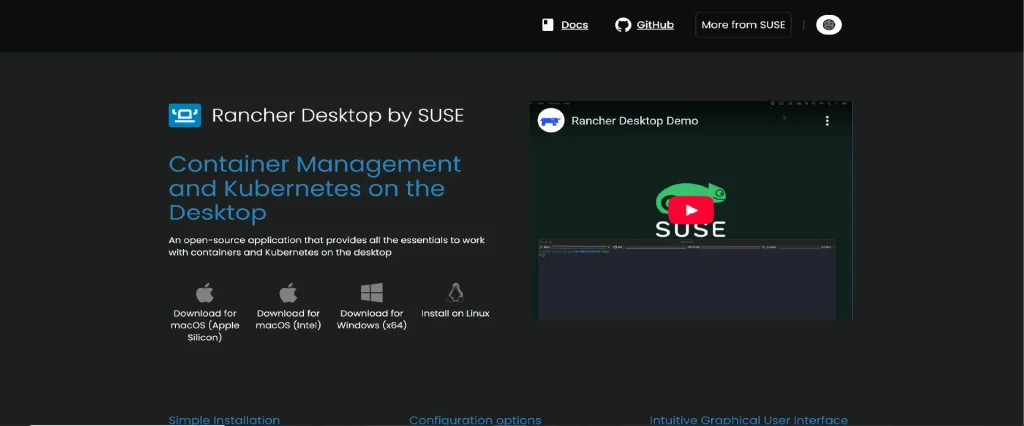
Rancher Desktop is a user-friendly application designed to simplify container and Kubernetes cluster management directly from your desktop. It aims to streamline local development by providing an accessible graphical interface.
Key Features:
- Intuitive GUI: It offers a clean and easy-to-use graphical interface. This simplifies container and Kubernetes management, eliminating the complexity often linked to command-line tools.
- Versatile Runtime Support: Supports both Containers and Docker runtimes, allowing developers to choose their preferred environment.
- Image Building with nerdctl: Integrates nerdctl for container image building and management. This provides a Docker-like experience with additional flexibility.
Feature Comparison:
| Feature | Docker | Rancher Desktop |
|---|---|---|
| Architecture | Command-line and GUI options for container management | GUI-centric platform focused on local container and Kubernetes management |
| Security | Standard security practices | Secure local management through a graphical interface |
| Resource Usage | Moderate, with performance tuning options | Lightweight, suitablefor desktop environments |
| Ease of Use | Popular, with extensive documentation | Extremely user-friendly, emphasizing GUI-based workflows |
| Use Cases | Suitable for development and production environments | Best for developers working on local container and Kubernetes setup |
Once you have identified the right solution, the next phase is understanding the migration process. You need to transition from Docker to your chosen alternative without disrupting your operations. So, let’s get into this.
How to Successfully Migrate from Docker to an Alternative?
Transitioning from Docker to an alternative containerization platform is a critical process that requires careful planning, execution, and validation. A well-structured approach minimizes disruption and ensures your containerized workloads continue running smoothly.
Follow these steps to drive a successful migration:
1. Assess Your Current Environment
Begin by conducting a complete evaluation of your existing Docker setup:
- Identify all containerized applications, dependencies, volumes, and network configurations.
- Pinpoint any Docker-specific features or workflows that may require adjustments in the new environment.
2. Select the Right Alternative
Choose a container platform that aligns with your technical requirements and organizational goals. Key factors to consider:
- Compatibility with your workload
- Performance benchmarks
- Scalability for future growth
- Team Adoption: Engage stakeholders to confirm that the selected tool meets business and operational needs.
3. Define a Clear Migration Roadmap
Develop a detailed migration strategy:
- Set realistic timelines and milestones
- Allocate resources, including personnel and infrastructure.
- Establish measurable success criteria to track progress.
4. Migrate Container Images
Evaluate if your Docker images need modification for the new platform.
- Use tools like Skopeo to transfer images across registries efficiently.
- Validate image integrity and compatibility post-migration.
5. Translate Commands & Configurations
Map your existing Docker commands and configurations to their equivalents in the new platform:
- Prepare a command translation guide for your team.
- Update the Docker Compose files, environment variables, and deployment scripts as necessary.
6. Test Extensively
Rigorous testing is vital to prevent downtime and ensure reliability:
- Deploy containers in a staging environment.
- Simulate production scenarios to verify performance and functionality.
7. Implement Operational Best Practices
Adopt new processes suitable to the alternative platform:
- Set up flawless monitoring, logging, and security protocols.
- Train your team on platform-specific capabilities.
8. Minimize Downtime
Schedule the production cutover during low-traffic hours to reduce business disruption:
- Prepare failover mechanisms and backups to safeguard data.
- Execute the migration incrementally, if possible, to limit risk.
9. Post-Migration Monitoring & Optimization
Once migrated, closely monitor system performance and user feedback:
- Quickly identify and address any issues.
- ntinuously promote your new environment to ensure long-term stability and efficiency.
Expedite Your Success: Build, Launch, and Scale Faster with Clustox
Migration to Docker alternatives allows businesses more flexible, secure, and scalable container solutions, ensuring that their infrastructure remains future-ready.
However, navigating this transition can be complex, requiring in-depth expertise and strategic planning. That’s where Clustox can help. As a trusted technology partner, Clustox specializes in cloud solutions and DevOps consulting.
We work closely with organizations to evaluate their current infrastructure. We ensure that your container ecosystem is suitable for better performance.
Simplify your operations with our all-in-one cloud platform: the ultimate solution for absolute efficiency!
Are Docker alternatives reliable for production use?
Yes, many alternatives, such as Kubernetes, OpenShift, and CRI-O, are built for production environments. They offer advanced features, scalability, and enterprise-level performance, making them ideal for large-scale deployments.
How do I select the best Docker alternative?
Evaluate your specific needs and consider factors like scalability, security, ease of use, and compatibility with your existing systems. Running pilot tests with different solutions can help you identify the best fit.

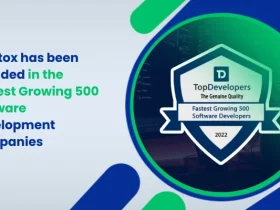






Share your thoughts about this blog!